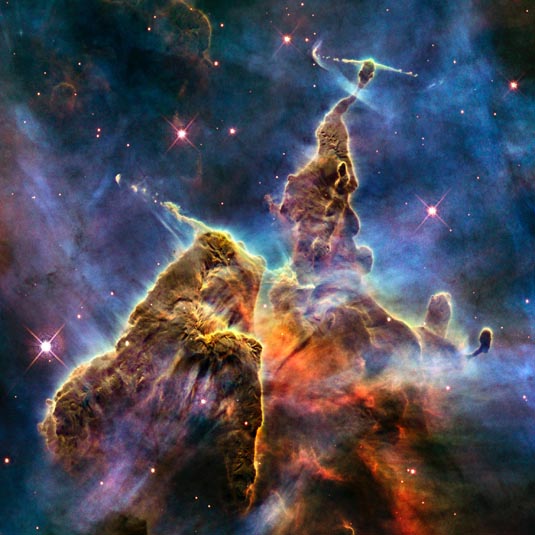
Carina Nebula Star-forming Pillars & Herbig-Haro Objects with Jets
RA 10h 44m 05s.25 Dec. -59° 29' 45".00
Carina
7,500 light-years (2,300 parsecs)
84 arcseconds (3.1 light-years or 0.94 parsec) wide.
NASA, ESA, and M. Livio and the Hubble 20th Anniversary Team (STScI)
April 22, 2010
Details: Closeup Comparison WideView
Other: 2000 2007 2009a 2009b 2010 2011a 2011b 2012a 2012b 2018
ABOUT THIS IMAGE:
This craggy fantasy mountaintop enshrouded by wispy clouds looks like a bizarre landscape from Tolkien's "The Lord of the Rings" or a Dr. Seuss book, depending on your imagination. The NASA Hubble Space Telescope image, which is even more dramatic than fiction, captures the chaotic activity atop a three-light-year-tall pillar of gas and dust that is being eaten away by the brilliant light from nearby bright stars. The pillar is also being assaulted from within, as infant stars buried inside it fire off jets of gas that can be seen streaming from towering peaks.
This turbulent cosmic pinnacle lies within a tempestuous stellar nursery called the Carina Nebula, located 7,500 light-years away in the southern constellation Carina. The image celebrates the 20th anniversary of Hubble's launch and deployment into an orbit around Earth.
Scorching radiation and fast winds (streams of charged particles) from super-hot newborn stars in the nebula are shaping and compressing the pillar, causing new stars to form within it. Streamers of hot ionized gas can be seen flowing off the ridges of the structure, and wispy veils of gas and dust, illuminated by starlight, float around its towering peaks. The denser parts of the pillar are resisting being eroded by radiation much like a towering butte in Utah's Monument Valley withstands erosion by water and wind.
Nestled inside this dense mountain are fledgling stars. Long streamers of gas can be seen shooting in opposite directions off the pedestal at the top of the image. Another pair of jets is visible at another peak near the center of the image. These jets (known as HH 901 and HH 902, respectively) are the signpost for new star birth. The jets are launched by swirling disks around the young stars, which allow material to slowly accrete onto the stars' surfaces.
Hubble's Wide Field Camera 3 observed the pillar on Feb. 1-2, 2010. The colors in this composite image correspond to the glow of oxygen (blue), hydrogen and nitrogen (green), and sulfur (red).
This image is a composite
of separate exposures made by the WFC3 instrument on the Hubble Space
Telescope (HST). Each filter was used to sample a narrow wavelength range
over a broad range of the visible colors. The composite color results
from assigning different hues (colors) to each monochromatic (grayscale)
image associated with an individual filter. In this case, the assigned
colors are:
WFC3/UVIS (Visible) WFC3/IR
(Infrared)
F673N ([S II]) - red F126N
([Fe II]) - red
F657N (H-alpha+[N II])
- green F128N
(Paschen-beta) - green
F502N ([O III]) - blue F164N
([Fe II]) - blue